Since the Paulson Center opened last semester, Crave NYU has quickly become a fan-favorite dining hall for its large variety of consistently good meal options. Crave’s different food provider, Sous Vide Kitchen, may be the cause behind its unique meal options and near-instant success, but is everything they come up with a guaranteed hit? When Crave got rid of its “City of Mac” customizable mac ‘n’ cheese bowls in favor of Vindy, we needed to find out for ourselves.
Sous Vide Kitchen advertises the Vindy station as Indian-inspired, seemingly absolving themselves of any obligation to authenticity. Compared to the previously opened “Chaat House,” an Indian food station at the Palladium dining hall, Vindy takes a more Westernized approach to Indian cuisine, preparing meals in non-traditional formats like bowls and hoagies. While the ambiguous use of the word “chaat” and the inclusion of samosas in a rice bowl are confusing, here is our attempt at understanding NYU’s approach to Indian food.
Samosa Chaat and Samosa Rice Bowl
The Samosa Chaat and Samosa Rice Bowl were a disappointing start. Both items included three samosas — filled with a typical combination of potatoes and peas spiced with fenugreek — on a bed of coconut jasmine rice and quinoa. The two dishes were differentiated by their toppings. While the Samosa Rice Bowl is advertised as including cucumber, tangy slaw and vindaloo sauce, the Samosa Chaat claimed to be garnished with chaat, pickled red onion and cilantro. Chaat is typically described as a category of savory Indian street snacks, so it was unclear what this descriptor was doing on the ingredients list, let alone describing a dish including rice.
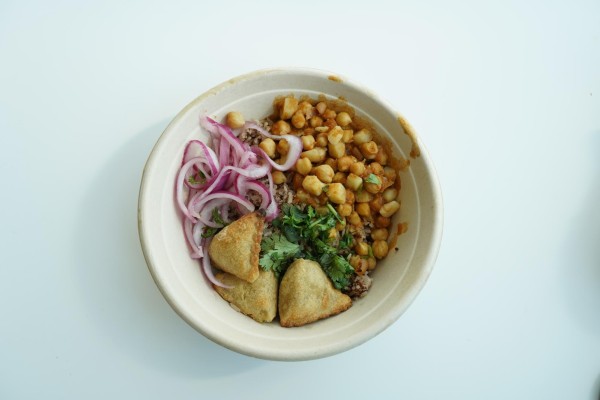
What we received was quite different from the descriptions. Though both had the same base items, the Samosa Rice Bowl was missing the vindaloo sauce and was topped instead with aloo chole, a potato and chickpea masala curry, and pickled red onion. The Samosa Chaat was an even bigger letdown, being devoid of all promised toppings but containing a meager portion of aloo chole. The coconut rice and quinoa had a mild, sweet flavor, confusing the flavor profile. Furthermore, the addition of quinoa provided no textural difference, feeling more like a sad attempt at upping the nutritional value. While the aloo chole was enjoyable on its own, the lack of sauce made it so there wasn’t enough to season all the rice. The samosas were the dish’s sole saving grace, with a well-spiced filling and crispy shell. However, the samosas, a typical snack, did not make for a cohesive dish. They simply do not belong in a rice bowl.
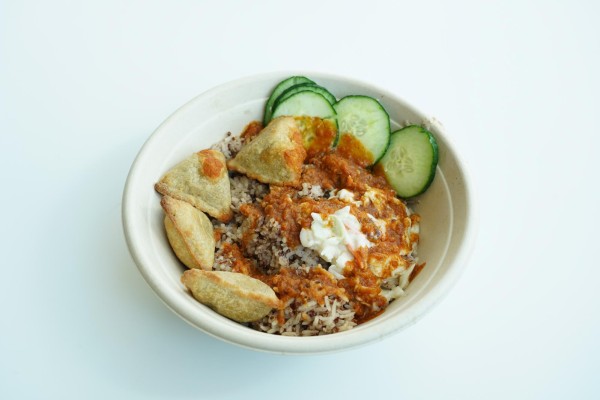
Tikka Masala Rice Bowl and Tikki Alu Chole
The Tikka Masala Rice Bowl and Tikki Alu Chole were an improvement compared to the samosa letdowns, although still not quite meeting expectations. Despite a few improvements, they included the same base of coconut jasmine rice and quinoa, and continued the trend of confusing toppings. The Tikki Alu Chole promised tikkis, pickled red onion, cilantro, chimichurri sauce and more of the indeterminate chaat. The Tikki Alu Chole lacked the chimichurri sauce, though it was included in the Masala Rice Bowl, for some reason — conflicting with the Grubhub ingredient breakdown. The Masala Rice Bowl did have butter beans, fire-roasted veggies, cilantro and tikka masala sauce, but it also came with tikki — spiced potato patties — instead of the promised samosas.
Like the samosa items, there was, once again, a disproportionate amount of rice to sauce. While the aloo chole was enjoyable, the dish definitely needed more of it to counteract the amount of rice in the bowl. Unlike the samosas, which felt out of place surrounded by the strangely sweet rice, the tikkis were a more reasonable pairing.
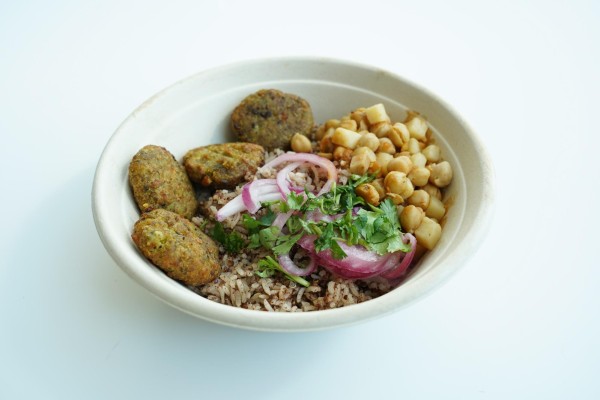
Halal Ball Bowl
The Halal Ball Bowl was a largely forgettable item, but because this is a review, we’ll tell you what we remember about it. Apart from the omission of cilantro, the bowl included all the listed components including — once again — coconut jasmine rice and quinoa, as well as halal meatballs, pickled red onion and chaat, which just turned out to be the ever-popular aloo chole.
While the flavor was good, the chicken and beef meatball was extremely dry. The aloo chole attempted to resolve this issue, but it instead made for a disjointed combination of textures and flavors. The pickled red onion was a nice addition of acidity and the only element that was even mildly successful at pulling the dish together.
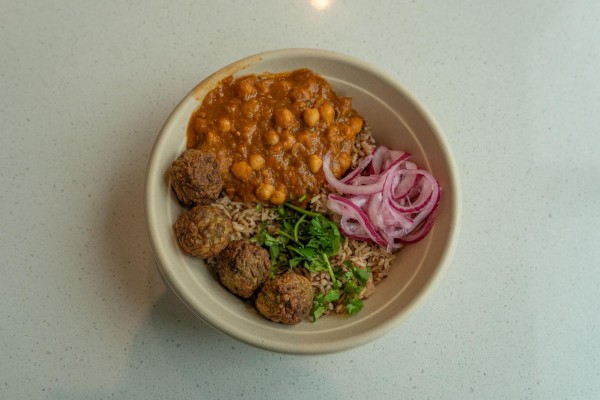
Halal Ball Hoagie and Masaledar Tikki Pao Sandwich
The Halal Ball Hoagie and its vegetarian twin, the Masaledar Tikki Pao Sandwich, were the clear standout items from the menu. Differing from all the other rice-based options, both these dishes include a hoagie roll, tikka masala curry sauce, boom boom sauce, sliced cucumbers and green cabbage. The Halal Ball Hoagie’s main protein is a chicken and beef meatball, while the Masaledar Tikki Pao Sandwich comes with a vegan potato-based tikki.
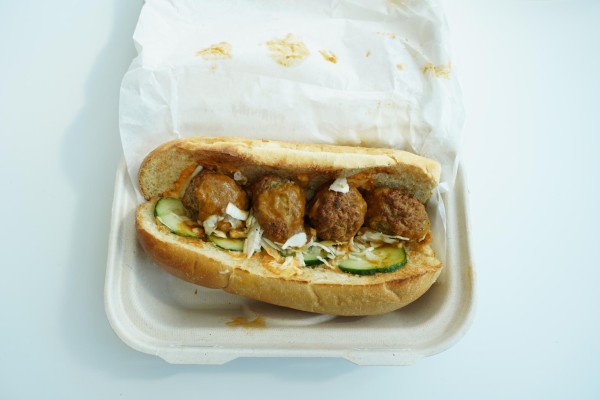
The tikkis were crispy on the outside and perfectly moist on the inside, and while the meatballs were dry, the condiments made up for it and proved a well-spiced combination. The tikka masala sauce on top was a creamy tomato-based sauce with a spicy kick. The boom boom sauce, on the other hand, was reminiscent of Thousand Island dressing, with its slight sweetness complementing the more savory elements. The cucumbers and cabbage provided a refreshing crunch throughout. Overall, both sandwiches came together with a great combination of flavors and textures.
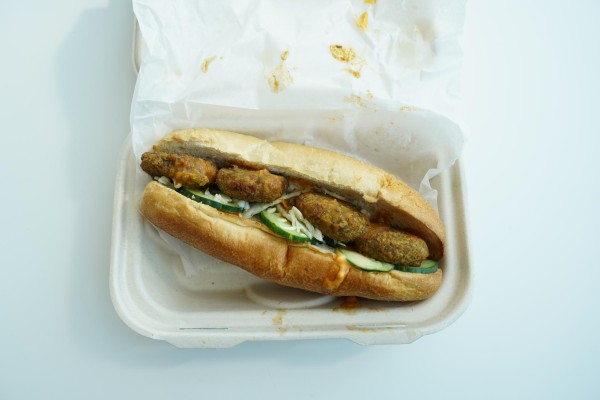
When it comes to Vindy, it is very important to remember that it will not be a taste of home — but then again, what NYU dining option is? The flavors of the individual components of the dishes are good, but the ways they are combined and the general inconsistency make Vindy a hit-or-miss option.
After trying every Vindy option, our top two recommendations would have to be the Halal Ball Hoagie and the Masaledar Tikki Pao Sandwich. When it comes to the other dishes, imagine they’re from a bougie, gentrified New York City restaurant. Then, maybe, you’ll be more likely to enjoy them.
Contact Shiphrah Moses and Reva Sharma at [email protected].


























































































































































Bhavana • Oct 6, 2023 at 6:28 pm
Love the article. Helpful to know Will go by your advice.